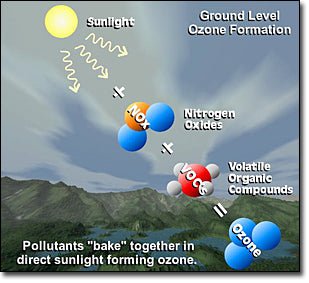Tropospheric ozone, often referred to as ground-level ozone, is created through a series of chemical reactions involving volatile organic compounds (VOCs), nitrogen oxides (NOx), and sunlight (ultraviolet light). Here's a basic overview of how this process works:
1. Emission of Precursors: The process begins with the emission of VOCs and NOx. These emissions primarily come from human activities such as the burning of fossil fuels (like gasoline and diesel), industrial processes, and certain chemical solvents. Natural sources, such as vegetation, also emit VOCs.
2. Photochemical Reactions: Once in the atmosphere, these precursors (VOCs and NOx) interact with sunlight, particularly ultraviolet light. This interaction triggers a series of complex photochemical reactions. In simple terms, the energy from the sunlight causes the VOCs and NOx to break apart and recombine in different ways.
3. Formation of Ozone: One of the key reactions involves the combination of oxygen molecules (O2) with oxygen atoms (O) that have been freed by the previous reactions. This combination forms ozone (O3).
4. Role of Sunlight and Temperature: Sunlight and temperature play a crucial role in this process. Higher temperatures and stronger sunlight accelerate the photochemical reactions, leading to higher concentrations of ozone. This is why ozone levels are typically higher on hot, sunny days.
5. Dynamic Nature: It's important to note that the formation of tropospheric ozone is a dynamic process, influenced by various factors including weather conditions, time of day, and geographic location.
6. Impact on Air Quality and Health: Tropospheric ozone is a major component of smog and a significant air pollutant. It can have various health effects, including respiratory problems, and also impacts the environment, contributing to the degradation of plants and ecosystems.
In summary, tropospheric ozone is not emitted directly into the atmosphere but is formed through chemical reactions involving precursor pollutants (VOCs and NOx) in the presence of sunlight.



Share:
Lessons Learned from the Mount St. Helens Eruption of 1980
Top April 2024 Eclipse Viewing Locations in Mexico